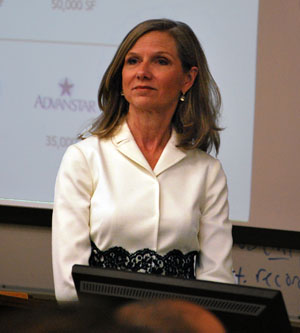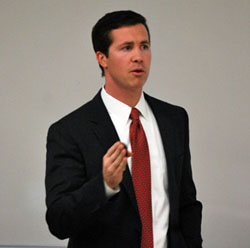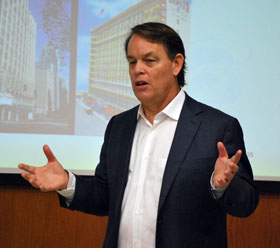Real estate experts study office space
By Lori Craig
 |
| Cushman & Wakefield Vice Chairman Lynn Williams '82 |
Wilshire Grand is just the beginning. The new high-rise, which last weekend had the largest uninterrupted concrete pour on record, will alter the future skyline of Los Angeles when it becomes the tallest structure west of the Mississippi. But far greater – if less visible – changes downtown must be sustained to keep the city center thriving, according to three real estate experts who spoke to USC Gould students recently.
Lynn Williams ’82, vice chairman of Cushman & Wakefield; Patrick Ramsey ‘76, partner in the Real Estate practice of Paul Hastings; and Jeffrey Welch, executive director of Cushman & Wakefield, addressed the future of office space in downtown Los Angeles at an event sponsored by the Business Law Society and the Real Estate Law Society.
While the Wilshire Grand tower – L.A.’s first new high-rise since 1993 – is expected to turn a profit thanks to a four-star hotel occupying the top floors, downtown’s best bet is to attract innovative businesses that want alternative office space.
“Who are these ‘new innovators’? Fashion, entertainment, media, advertising, creative, startups … a very distinct class of tenants and businesses in our economy,” Welch said.
Downtown Los Angeles grew up as an oil town, and a building boom in the 1960s through the ‘80s created the skyline we see today.
“The problem with downtown Los Angeles is the industries that are [there] are non-growth right now,” Welch said.
The top 15 tenants of downtown office space are in service-based industries: “FIRE” (finance, insurance, real estate) and legal, including City National Bank, Union Bank, Southern California Gas Company, Latham & Watkins, Gibson Dunn, Paul Hastings and others.
 |
| Jeffrey Welch, executive director of Cushman & Wakefield |
“While you’ve got a lot of health downtown, there are business that are here, they’re not companies that are growing – in fact, they’re shrinking,” Welch said. “Law firms have been decimated over the last seven years … plus, space needs are changing.”
With vacancies increasing, and to attract new innovators, downtown needs to provide “creative space” instead, Williams said.
“The tech companies, these new innovators, their stock-in-trade is collaboration and energy,” Williams said. “In order to do that, they need to construct office space that really encourages that.”
Open-concept offices, natural light, and creative meeting spaces are key to attracting thriving businesses downtown, Williams said.
She and Welch pointed to San Francisco’s South of Market (“SoMa”) neighborhood as an ideal model for downtown L.A. The area’s large warehouses are home to heavy-hitters including Salesforce.com, Yelp, Zynga, REI and others.
Key to downtown’s success are several other changes already underway: a cleaner city and safer downtown; public transportation options; and the residential units and businesses (restaurants, cultural attractions, other retail, etc.) that support a 24/7 rather than 9-to-5 downtown.
“Broadway has it all,” Williams said, noting the street is home to the Los Angeles Brewing Company, the Ace Hotel, and the Figaro café. “It is the perfect example of new restaurants, new retail, new hotels, and new residential. It’s phenomenal.”
 |
| Patrick Ramsey '76, partner at Paul Hastings |
New apartment construction has grown tremendously, bringing a larger labor force and a younger demographic – including many USC students – to downtown, sustaining its resurgence, Ramsey said.
People outside L.A. are taking note, Ramsey said. GQ magazine named downtown Los Angeles “America’s next great city,” while the New York Times named downtown No. 5 on its list of 52 places to go in 2014 – and only one other locale in the top 10 was in America.
In fact, downtown is changing at such a rapid pace that Welch said the non-high-rise rental market has “changed tremendously” in just the past 12 months.
“Are the new innovators going to come? Yes, at least some of them will,” Ramsey said. The biggest challenge, he noted, is that tech and media companies already housed on the west side or in Playa Vista want to see a success story before they make the move. “What we need to have happen to be a huge whopping success is we need some very, very significant tenants, primarily tech or media, to come to downtown. That hasn’t happened. The alternative to that, which sort of happened in [San Francisco], is that, of all those little incubator companies that started up [there], one, two or three of them have to make it big.”

















